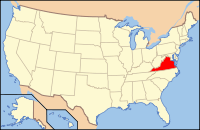Waterford, Virginia
| Waterford, Virginia | |
|---|---|
| Unincorporated village | |
 | |
 Waterford, Virginia | |
| Coordinates: 39°11′12″N 77°36′36″W / 39.18667°N 77.61000°WCoordinates: 39°11′12″N 77°36′36″W / 39.18667°N 77.61000°W | |
| Country |
|
| State |
|
| County |
|
| Time zone | Eastern (EST) (UTC-5) |
| • Summer (DST) | EDT (UTC-4) |
| ZIP codes | 20197 |
|
Waterford Historic District | |
| Governing body | Local |
|---|---|
| NRHP Reference # | 69000256 |
| VLR # | 401-0123 |
| Significant dates | |
| Added to NRHP | June 3, 1969[1] |
| Designated NHLD | April 15, 1970[2] |
| Designated VLR | May 13, 1969[3] |

Waterford is an unincorporated village in the Catoctin Valley of Loudoun County, Virginia, located along Catoctin Creek. Waterford is 47 miles (76 km) northwest of Washington, D.C., and 7 miles (11 km) northwest of Leesburg. The entire village and surrounding countryside is a National Historic Landmark district.
History
Founding
Waterford was established around 1733 by Amos Janney, a Quaker from Bucks County, Pennsylvania. Janney purchased 400 acres (1.6 km2) on the south fork of Catoctin Creek and established a grist mill and saw mill in the area in the 1740s. Due to the success of the mills, the settlement became known as "Janney's Mill". The town grew quickly as a center of commerce for growers of grain.[4]
Growth
Amos Janney died in 1747, leaving his estate to his sixteen-year-old son, Mahlon. Mahlon replaced the original log mill with a two-story structure. The village continued to grow, and in 1780, 12 acres (49,000 m2) on the south side of Main Street were subdivided into 15 lots, upon which shops and homes were built. By the 1790s, the village was known as Waterford, named after the city of Waterford, in Ireland, where some of its founders had once lived before immigrating to the United States. New residents continued to come from Pennsylvania, as Quakers were followed by Presbyterians, Lutherans, Baptists, and Methodists. Waterford was also populated by African-Americans, both free and enslaved.[5]
Civil War
By the start of the Civil War, the population of Waterford remained largely Quaker. As pacifists and abolitionists,[6] the Quakers remained loyal to the Union throughout the war. Waterford was the scene of a fierce fight between the county's Unionist and Confederate partisan units, the Loudoun Rangers and White's Rebels, respectively.
Waterford today
The town today is largely residential, although a number of businesses are based in the village. The Loudoun Mutual Insurance Company has been located in Waterford since 1849.[7][8]
National Historic Landmark
The Waterford Historic District is a National Historic Landmark and is listed on the National Register of Historic Places. It was listed as a Virginia Historic Landmark in 1969.[9] Waterford and a significant portion of its surrounding countryside was declared a National Historic Landmark in 1970.[2] Significant buildings include the mill (circa 1750), Arch House Row (circa 1750), Camelot School (circa 1800) and the 1882 Presbyterian church.[10]
The Catoctin Creek Bridge was listed on the National Register of Historic Places in 1974, and the William Virts House was listed in 2011.[1][11]
References
- ↑ 1.0 1.1 "National Register Information System". National Register of Historic Places. National Park Service. 2007-01-23.
- ↑ 2.0 2.1 "Waterford Historic District". National Historic Landmark summary listing. National Park Service. Retrieved 2008-04-21.
- ↑ "Virginia Landmarks Register". Virginia Department of Historic Resources. Retrieved 5 June 2013.
- ↑ http://www.waterfordfoundation.org/history/quakers.html
- ↑ http://www.waterfordfoundation.org/history/growth.html
- ↑ http://cghs.dadeschools.net/slavery/anti-slavery_movement/quakers.htm
- ↑ http://www.loudounmutual.com/aboutus_1.cfm
- ↑ http://www.zipperpages.com/Loudoun_Mutual_Insurance_Company-of-Waterford_VA/6913844.html
- ↑ Staff, Virginia Historic Landmarks Commission, James W. Moody, Jr., Director (May 23, 1969), National Register of Historic Places Inventory-Nomination: Waterford Historic District PDF (32 KB), National Park Service (with property zone map and more)
- ↑ Staff, Virginia Historic Landmarks Commission, James W. Moody, Jr., Director (May 23, 1969), National Register of Historic Places Inventory-Nomination: Waterford Historic District PDF (32 KB), National Park Service and Accompanying 16 photos, from 1969 PDF (32 KB)
- ↑ "National Register of Historic Places Listings". Weekly List of Actions Taken on Properties: February 2011. National Park Service. 2011-03-04.
External links
- Waterford Citizen's Association
- The Waterford Foundation
- Waterford History
- Waterford, Virginia: From Mill Town to National Historic Landmark, a National Park Service Teaching with Historic Places (TwHP) lesson plan
- A color, contour map of the district is here.
- Waterford Historic District, Loudoun County, 4 photos at Virginia DHR
- Numerous photo sets available for Waterford VA properties, search on "Waterford VA" here, at Historic American Building Survey
| |||||||||||||||||


